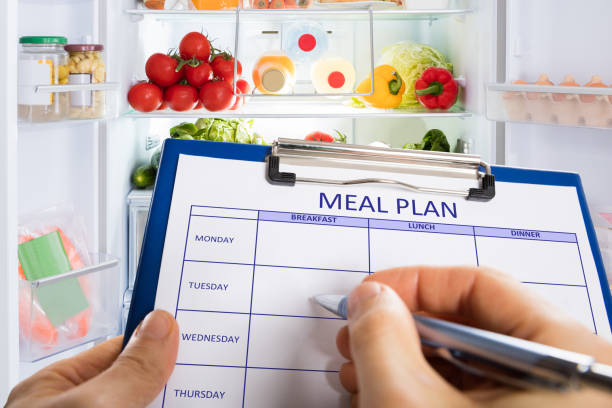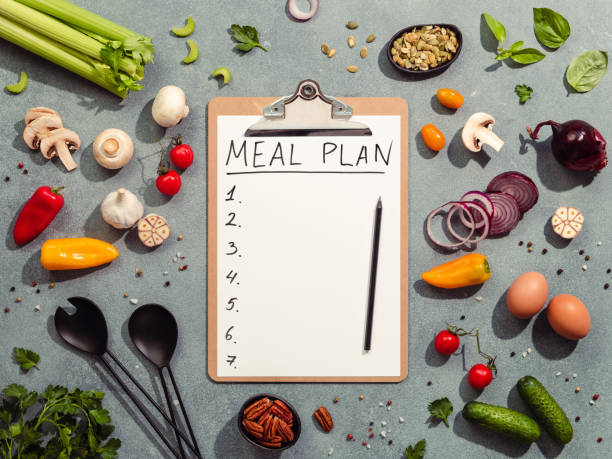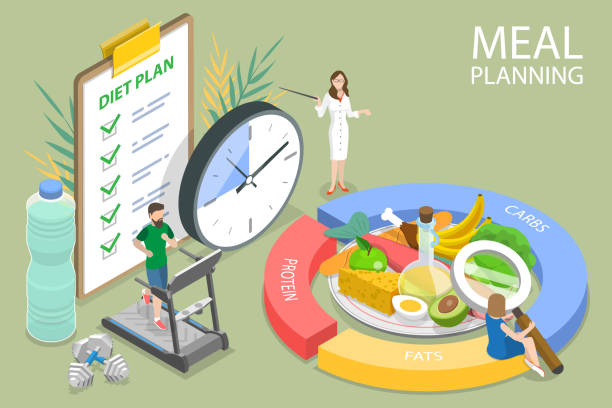Living with diabetes doesn’t mean giving up your favorite foods—it simply means learning how to balance them in the right way. A diabetes-friendly meal plan is designed to help you manage blood sugar levels, maintain a healthy weight, and lower the risk of long-term complications like heart disease or nerve damage. The best part? You don’t have to stick to a strict, tasteless, or boring diet.
Instead, it’s about making small but smart choices—like choosing whole grains over refined carbs, adding more fiber-rich vegetables, and keeping portion sizes in check. By planning ahead and knowing which foods work best for your body, you can enjoy flavorful, satisfying meals that fit your lifestyle and support your health goals.
This step-by-step guide will walk you through how to create a balanced, flexible, and enjoyable meal plan designed for people with diabetes. You’ll learn how to pick the right foods, control portions, and build meals that keep your blood sugar steady throughout the day.
A diabetes-friendly meal plan doesn’t mean cutting out everything you love—it means learning how to enjoy your favorite foods in moderation while still meeting your health goals. With the right tools and strategies, you can create a plan that works for your lifestyle, helps you stay energized, and reduces the risk of complications.
Why a Diabetes-Friendly Meal Plan Matters
Managing diabetes goes beyond checking your blood sugar or taking medication. The food you eat plays a huge role in how your body reacts, and every meal is an opportunity to support better health. A good meal plan can do more than just control blood sugar—it can also help you feel better day to day and reduce the risk of long-term complications. For example, a well-balanced plan can:
- Keep blood sugar steady throughout the day so you avoid dangerous highs and lows.
- Prevent energy crashes and sugar spikes that leave you feeling tired or shaky.
- Support weight loss or healthy weight maintenance, which lowers insulin resistance.
- Improve heart health by reducing cholesterol, blood pressure, and inflammation.
- Give you confidence when making food choices, whether at home, work, or dining out.
According to the American Diabetes Association, healthy eating is the cornerstone of diabetes care. When paired with regular physical activity, stress management, and medical guidance, a diabetes-friendly meal plan can boost your energy, lower your risk of complications, and improve your overall well-being.

Step 1: Understand the Basics of Diabetes Nutrition
Before planning your meals, it’s important to understand how food affects blood sugar. Here are the main nutrients to focus on:
Carbohydrates (Carbs)
Carbs have the biggest effect on blood sugar. Instead of cutting them out, choose complex carbs that digest slowly. Examples:
- Whole grains (brown rice, oats, quinoa)
- Legumes (lentils, beans, chickpeas)
- Vegetables (broccoli, spinach, carrots)
Protein
Protein helps you feel full and keeps blood sugar stable. Examples:
- Chicken, turkey, fish
- Eggs
- Tofu and tempeh
- Greek yogurt
Healthy Fats
Fats slow digestion and support heart health, which is vital for people with diabetes. Examples:
- Avocado
- Nuts and seeds
- Olive oil
- Fatty fish like salmon
Step 2: Follow the Plate Method
The Diabetes Plate Method is one of the simplest and most effective ways to plan balanced meals without stress. Instead of worrying about complicated numbers or strict measurements, you can use your plate as a visual guide to build healthy portions. Here’s how your plate should look at each meal:
- ½ plate: Non-starchy vegetables like broccoli, spinach, peppers, cucumbers, or cauliflower. These foods are low in carbs, high in fiber, and packed with vitamins that help manage blood sugar.
- ¼ plate: Lean protein such as fish, chicken, turkey, eggs, or tofu. Protein keeps you full longer and helps your body build and repair muscle.
- ¼ plate: Healthy carbs like brown rice, quinoa, beans, lentils, or sweet potatoes. Choosing whole, fiber-rich carbs helps prevent sugar spikes and gives you lasting energy.
This method makes portion control easy and helps balance blood sugar without the need for calorie counting or complex tracking. It also allows flexibility, so you can enjoy a variety of foods while still staying on track. You can learn more about the Diabetes Plate Method from the Centers for Disease Control and Prevention (CDC), which recommends it as a simple tool for people living with diabetes.
Step 3: Build a Weekly Meal Plan
Creating a meal plan saves time and reduces stress. Here’s a step-by-step approach:
1. Plan Your Meals in Advance
- Choose 2–3 breakfast, lunch, and dinner options you can rotate.
- Keep ingredients simple to save money and time.
2. Prep Smart Snacks
Diabetes-friendly snacks prevent sugar crashes between meals. Good choices include:
- Apple slices with peanut butter
- Greek yogurt with chia seeds
- A handful of almonds
- Carrot sticks with hummus
3. Make a Grocery List
Stick to whole, fresh foods as much as possible. Avoid processed foods high in sugar and refined carbs.
Step 4: Control Portions Without Stress
Portion control is key for managing blood sugar because eating too much—even of healthy foods—can cause spikes. Learning how to manage serving sizes helps you enjoy balanced meals without feeling deprived. Here are some easy tips to practice portion control every day:
- Use smaller plates to naturally eat less without feeling like you’re missing out. A full small plate can look more satisfying than a half-empty large one.
- Measure carbs with your hand—your fist equals about 1 cup of carbs, while your palm is a good guide for one portion of protein. This makes it easy to estimate servings anywhere, even without measuring tools.
- Read food labels carefully to check serving sizes and understand how many carbs, calories, or fats are in the portion you’re eating. Many packaged foods contain more than one serving.
- Avoid second helpings by waiting 10 minutes before going back for more. This gives your body time to feel full and helps prevent overeating.
- Pre-portion snacks into small containers or bags instead of eating straight from the package, which can lead to mindless eating.
By practicing these simple strategies, you can better manage your blood sugar, support a healthy weight, and still enjoy the foods you love in the right amounts.

Step 5: Smart Food Swaps for Blood Sugar Control
You don’t have to give up your favorite foods—just make smarter swaps that satisfy cravings while keeping blood sugar steady. Small changes like these can make a big difference in your daily meals:
- White rice → Brown rice or cauliflower rice: Brown rice has more fiber, which slows sugar absorption. Cauliflower rice is a low-carb option that’s light but filling.
- White bread → Whole-grain bread: Whole grains provide more nutrients and fiber, helping you feel full longer and avoid sugar spikes.
- Sugary drinks → Sparkling water with lemon: Cutting out soda and juice reduces empty calories. Sparkling water with lemon, lime, or berries gives flavor without added sugar.
- Chips → Roasted chickpeas or nuts: These crunchy snacks are rich in protein and healthy fats, which support steady energy levels and better heart health.
- Ice cream → Frozen Greek yogurt with berries: This swap satisfies a sweet tooth while giving you protein, probiotics, and antioxidants.
By choosing these healthier alternatives, you can still enjoy the flavors you love while supporting better blood sugar control and overall health. Over time, your taste buds will adjust, and these swaps will feel natural and satisfying.
Step 6: Stay Flexible with Eating Out
Dining out doesn’t have to derail your meal plan. With a little preparation and smart choices, you can enjoy restaurant meals while still managing your blood sugar. Try these simple strategies when eating out:
- Check menus online before going so you can plan ahead and choose diabetes-friendly options instead of deciding on the spot.
- Ask for dressings and sauces on the side to control how much sugar, salt, or fat is added to your meal. Even small changes can make a big difference.
- Choose grilled, baked, or steamed dishes instead of fried foods. These cooking methods keep meals lighter and lower in unhealthy fats.
- Split large portions or ask for a to-go box before you start eating. Restaurant servings are often double what you need, and saving half for later helps with portion control.
- Swap sides like fries for vegetables or a side salad to add fiber and reduce empty carbs.
- Drink water instead of soda or sweetened drinks to cut down on extra sugar and calories.
By following these strategies, you can stick to your diabetes meal plan, enjoy your favorite restaurants, and feel good about your choices.
Step 7: Track Your Progress
Keeping track of meals helps you see what works best for your body and gives you a clearer picture of how food affects your blood sugar. When you track consistently, patterns start to show, making it easier to adjust your diet for better results. Here are simple ways to do it:
- Use a food diary or app to log meals so you can record what you eat, portion sizes, and times of day. Many apps even calculate carbs automatically.
- Note how you feel after eating by writing down your energy levels, mood, or if you notice sugar spikes or crashes. This helps connect your food choices with how your body responds.
- Share your logs with your doctor or dietitian so they can give personalized advice and help you fine-tune your meal plan.
Tracking isn’t about perfection—it’s about awareness. Over time, it helps you make smarter choices, avoid foods that trigger spikes, and find meals that keep you satisfied. Turning this into a routine can make healthy eating a long-term habit, not just a short-term goal.
Sample Diabetes Friendly Meal Plan
Here’s a one-day example you can try:
Breakfast
- Oatmeal topped with blueberries and walnuts
- Black coffee or unsweetened green tea
Snack
- Carrot sticks with hummus
Lunch
- Grilled chicken breast
- Quinoa and steamed broccoli
- Side salad with olive oil
Snack
- Greek yogurt with chia seeds
Dinner
- Baked salmon
- Roasted sweet potatoes
- Spinach and mushroom stir-fry
This simple structure can be repeated with different foods for variety.
Step 8: Work with a Professional
If you feel lost, talk to a registered dietitian or diabetes educator. These professionals are trained to guide people with diabetes and can help you create a meal plan that fits your unique needs. Instead of following a one-size-fits-all diet, you’ll get a plan that’s tailored to your:
- Age, since nutritional needs can change as you get older.
- Weight goals, whether you want to lose, gain, or maintain a healthy weight.
- Activity level, because people who exercise often may need more energy and carbs.
- Medications, since certain diabetes drugs or insulin require careful timing with meals.
Professional guidance ensures your meal plan supports both your health and your lifestyle. A dietitian or educator can also teach you practical skills like reading labels, counting carbs, and planning meals for busy days. With expert support, you’ll feel more confident about your choices and stay on track for long-term success.

Final Tips for Success
Along with a balanced meal plan, healthy habits play a big role in managing diabetes day to day. Small lifestyle choices can make a big difference for your blood sugar and overall well-being. Here are some simple but powerful reminders:
- Drink plenty of water throughout the day to stay hydrated and support better blood sugar control. Water also helps your body flush out excess sugar.
- Get regular exercise—even walking counts. Physical activity makes your body more sensitive to insulin and helps keep blood sugar steady. Aim for at least 30 minutes most days.
- Don’t skip meals—it can cause sugar drops that leave you feeling shaky, tired, or irritable. Eating regular, balanced meals keeps your energy levels stable.
- Be kind to yourself—progress matters more than perfection. Managing diabetes is a journey, and even small improvements add up over time. Focus on consistency, not strict rules.
These simple habits, when paired with mindful eating, can help you stay in control of your health and feel your best each day.
Conclusion: Take Control of Your Health Today
Creating a diabetes-friendly meal plan doesn’t have to be overwhelming or complicated. The key is to take it step by step and focus on small, realistic changes that you can maintain over time. By using simple strategies—like the Diabetes Plate Method, portion control, and smart food swaps—you can enjoy meals that are both satisfying and supportive of healthy blood sugar levels. These tools make it easier to plan your day without feeling restricted or deprived.
Remember, small changes add up to big results. You don’t need to change everything overnight. Start with one or two steps from this guide, such as swapping white bread for whole grain or adding more non-starchy vegetables to your plate. As these habits become part of your routine, you can build on them and create a balanced plan that fits your lifestyle. With consistency, you’ll find that managing diabetes becomes less stressful and more natural, allowing you to focus on enjoying food and feeling your best.
👉 What’s your biggest challenge when planning meals for diabetes? Share your thoughts in the comments—I’d love to hear from you!


